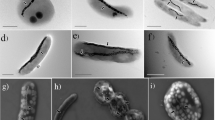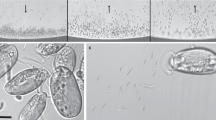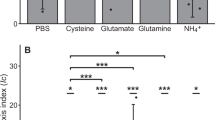Abstract
Several species of aquatic bacteria which orient in the Earth's magnetic field and swim along magnetic field lines in a preferred direction (magnetotaxis) have been observed in marine and freshwater sediments of the Northern Hemisphere1,2. Their orientation is due to one or more intracytoplasmic chains of single-domain magnetite particles3. These linearly arranged particles impart a net magnetic dipole moment to the bacterium, parallel to the axis of motility. Northern Hemisphere magnetotactic bacteria with unidirectional motility swim consistently in the direction of the magnetic field, that is, to the geomagnetic North1,2,4. This implies that their magnetic dipole is systematically orientated with the North-seeking pole forward. The magnetic polarity can be reversed by single, magnetic pulses of high field strength (1–2 µs, 300–600 G), and these bacteria then swim along magnetic field lines to the South5. Due to the inclination of the Earth's magnetic field, magnetotactic bacteria which swim to the North in the Northern Hemisphere are directed downward at an angle increasing with latitude. It has been suggested that this downward-directed motion confers a biological advantage by guiding the bacteria, when dislodged, back to the sediments1. On the basis of this hypothesis, magnetotactic bacteria of the Southern Hemisphere would be expected to swim to the South to reach the bottom. We report here several morphological types of magnetotactic bacteria present in sediments of the Southern Hemisphere. These bacteria indeed swim consistently to the South, hence downward along the Earth's inclined magnetic field lines, as hypothesized. As revealed by electron microscopy, they contain internal chains of electron-opaque particles similar to those observed in magnetotactic bacteria from the Northern Hemisphere. Like their Northern Hemisphere counterparts, their magnetic polarity can be permanently reversed and they cannot be demagnetized. We also report on Northern Hemisphere magnetotactic bacteria incubated in Southern Hemisphere magnetic conditions, confirming the biological relevance of downward directed motility.
This is a preview of subscription content, access via your institution
Access options
Subscribe to this journal
Receive 51 print issues and online access
$199.00 per year
only $3.90 per issue
Buy this article
- Purchase on Springer Link
- Instant access to full article PDF
Prices may be subject to local taxes which are calculated during checkout
Similar content being viewed by others
References
Blakemore, R. P. Science 190, 377 (1975).
Kalmijn, Ad. J. & Blakemore, R. P. Proc. int. Un. physiol. Sci. 13, 364 (1977).
Frankel, R. B., Blakemore, R. P. & Wolfe, R. S. Science 203, 355 (1979).
Moench, T. T. & Konetzka, W. A. Archs Microbiol. 119, 203 (1978).
Kalmijn, Ad. J. & Blakemore, R. P. in Animal Migration, Navigation and Homing (eds Schmidt-Koenig, K. & Keeton, W. T.) 344 (Springer, New York, 1978).
Kirschvink, J. L. J. exp. Biol. (in the press).
Balkwill, D. L., Maratea, D. & Blakemore, R. P. J. Bact 141, 1399 (1980).
Kalmijn, Ad. J. Handbook of Sensory Physiology Vol. III (ed. Fessard, A.) 147–200 (Springer, Berlin, 1974).
Frankel, R. B. & Blakemore, R. P. J. Magn. magn. Mater. 15–18, 1562 (1980).
Author information
Authors and Affiliations
Rights and permissions
About this article
Cite this article
Blakemore, R., Frankel, R. & Kalmijn, A. South-seeking magnetotactic bacteria in the Southern Hemisphere. Nature 286, 384–385 (1980). https://doi.org/10.1038/286384a0
Received:
Accepted:
Issue Date:
DOI: https://doi.org/10.1038/286384a0
This article is cited by
-
Discovery of late Quaternary giant magnetofossils in the Bay of Bengal
Communications Earth & Environment (2024)
-
Swimming polarity inversion in uncultured magnetotactic cocci
European Biophysics Journal (2024)
-
How light affect the magnetotactic behavior and reproduction of ellipsoidal multicellular magnetoglobules?
Journal of Oceanology and Limnology (2021)
-
Unconventional Physical Methods for Synthesis of Metal and Non-metal Nanoparticles: A Review
Proceedings of the National Academy of Sciences, India Section A: Physical Sciences (2019)
-
The swimming polarity of multicellular magnetotactic prokaryotes can change during an isolation process employing magnets: evidence of a relation between swimming polarity and magnetic moment intensity
European Biophysics Journal (2017)
Comments
By submitting a comment you agree to abide by our Terms and Community Guidelines. If you find something abusive or that does not comply with our terms or guidelines please flag it as inappropriate.



